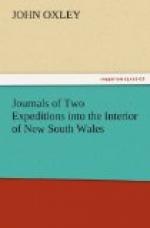October 20.—At four o’clock the people set out to bring the boat, and at two o’clock they had brought her safely to the tent, having gone in that time upwards of twenty-six miles, thirteen of which they carried a twelve feet boat on their shoulders; a proof how much may be effected by a steady perseverance. In fact, I had no occasion to be anxious for the result of any measure which at all depended on their personal exertions. We had the satisfaction to find that the boat would be easily repaired, wanting little besides caulking and oars, and we did not lose a moment in commencing the necessary operations. It has blown a gale of wind from the south all day, the surge breaking across the inlet with extreme violence: within the bar the water is very deep, and in moderate weather at flood tides there is doubtless a boat passage over the bar; for, notwithstanding the break, there appears a sufficient depth of water. Whatever channel there may be is on the north side of the entrance. I think, from the height of the rise of tide (between four and seven feet), and the rapidity with which it runs, that this inlet must penetrate a very considerable distance into the country; and probably the lake which we took to be fresh water under the two Southern Brothers, may be a principal branch of this lake. It appears to be high water at the full and change at about forty minutes after nine.
October 22.—Yesterday was employed in giving the boat such repairs as our means permitted. Before six o’clock this morning we had transported a good part of the baggage, when, the tide answering, we began towing the horses over, which we safely effected by half past eight. I consider the discovery of this boat most providential, for without its assistance we should never have been able to transport the horses: being obliged to cross near the entrance, the force of the tide and their own weakness would have swept them among the breakers, and they would consequently have perished. We lost no time in pursuing our journey up the coast, and had by four o’clock accomplished six miles, when, to our great mortification, another inlet barred our progress. The southerly gale. attended with incessant rain, had by this time increased to such a degree, that we could take no steps this evening to cross it. By the time the tents were pitched every thing was drenched with rain; and I think we felt the cold it occasioned more severely than on any similar occasion. I should be of opinion that this inlet communicated with the one we last crossed, as branches from each take such courses as would, I think, cause them to unite. The last inlet was named Harrington Lake, in honour of the noble earl of that title.




